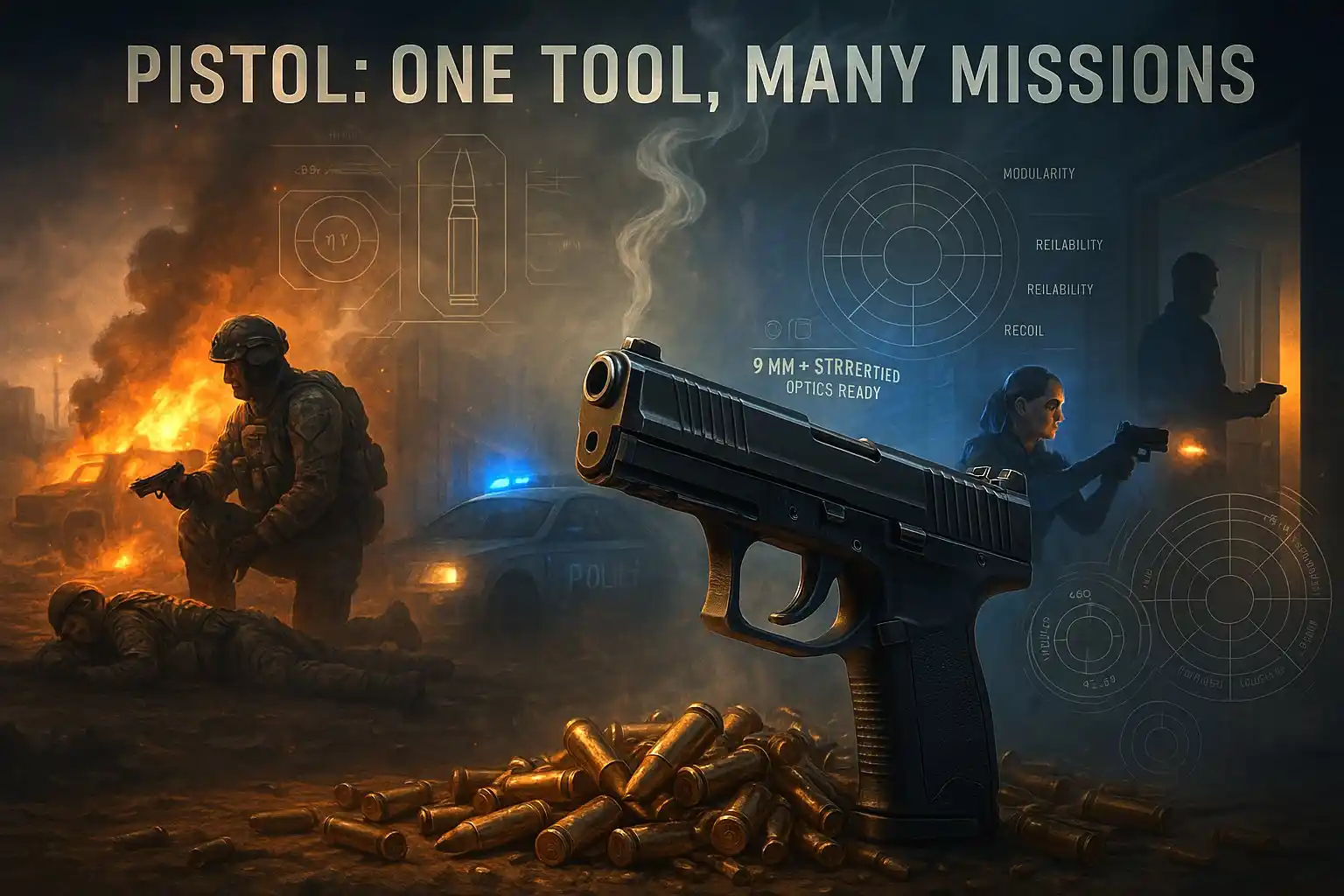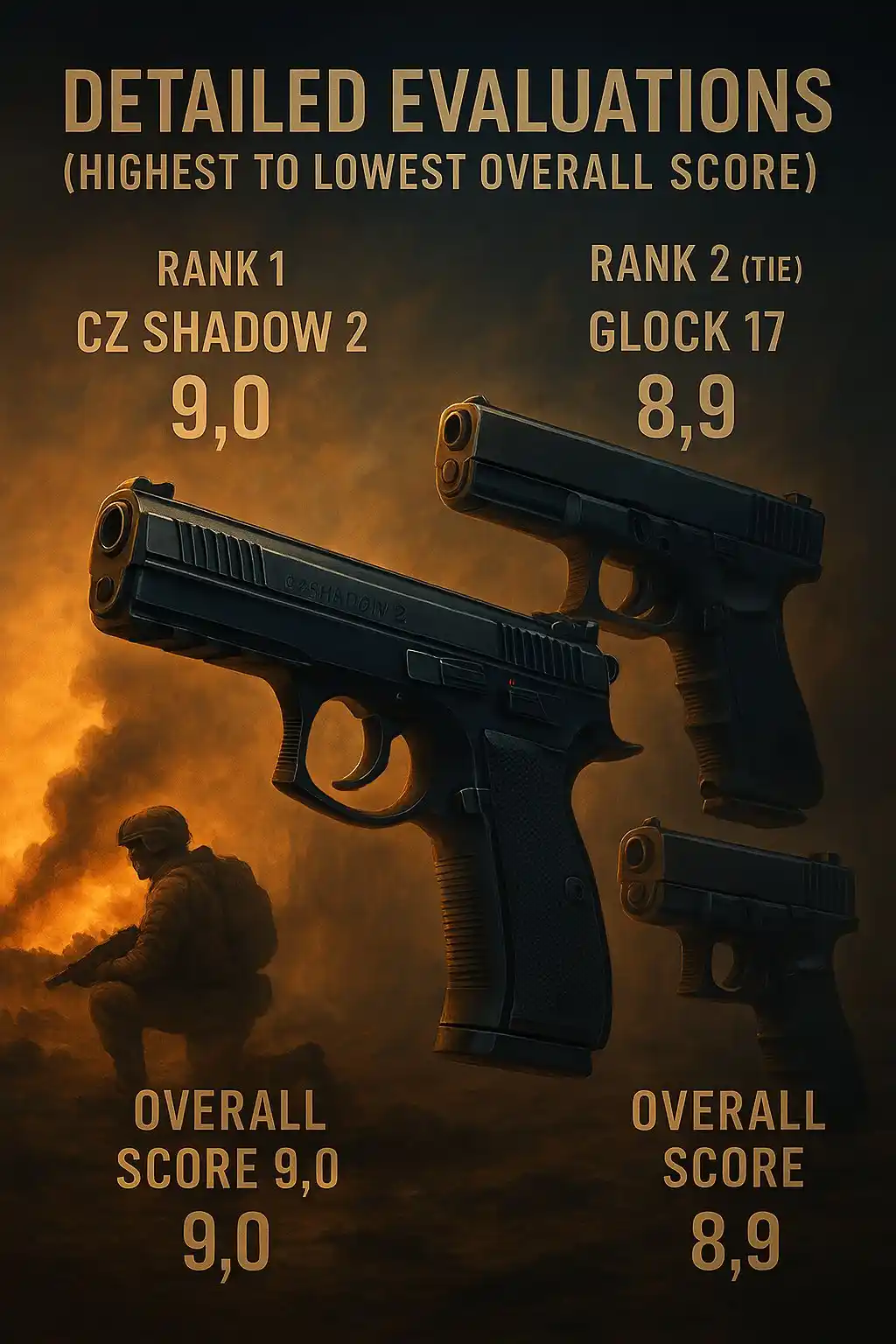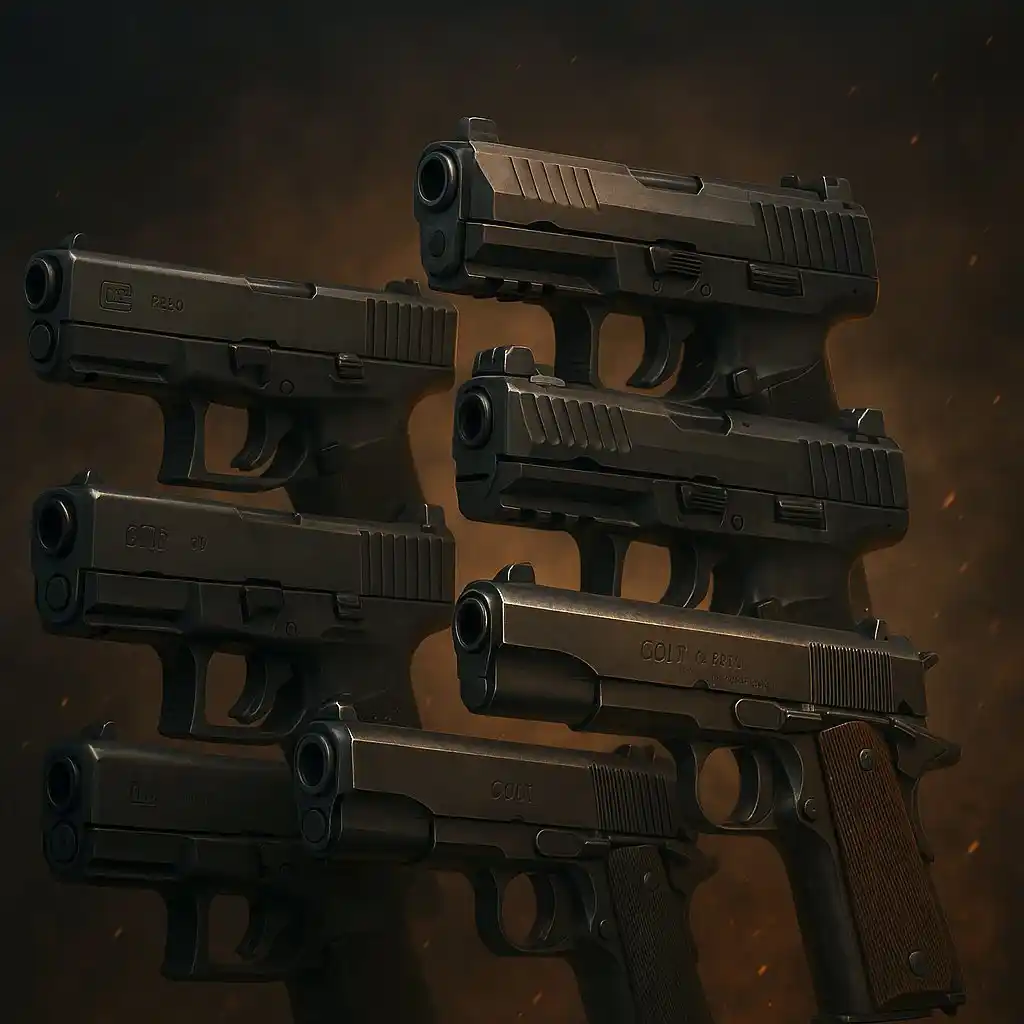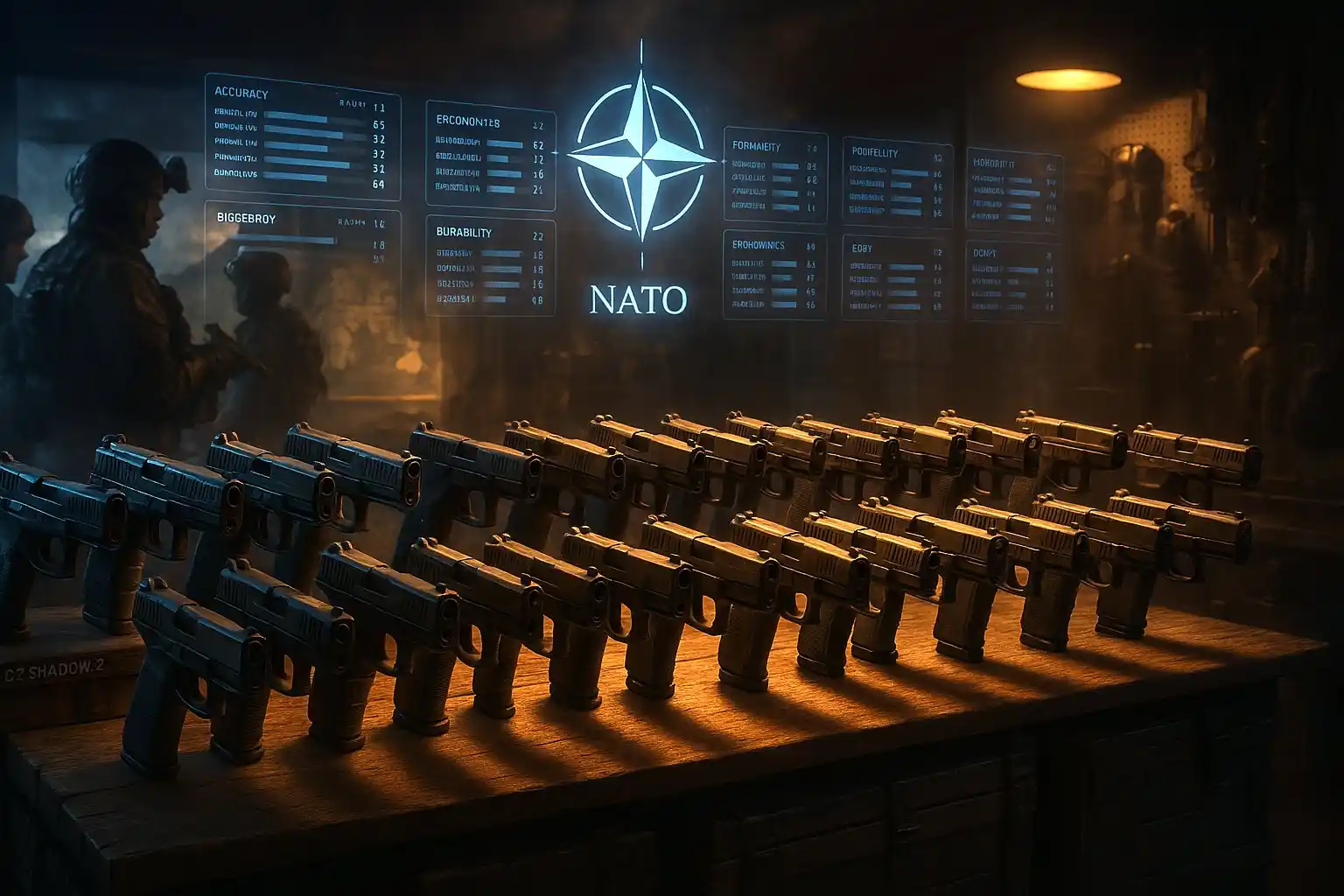
1. INTRODUCTION
1.1. NATO Context and Standardization
-
Polymer-framed, striker-fired designs that reduce weight, increase capacity, and simplify maintenance.
-
Modularity and optics-readiness, allowing sidearms to adapt to varied missions or user preferences.
1.2. Key Requirements for a “Top NATO-Service Pistol”
-
Reliability in Extreme Conditions. Pistols must tolerate dust, mud, subzero temperatures, saltwater exposure, and high round counts.
-
Accuracy & Consistency. Most sidearms, if well-designed, hold groups around 2 – 3 inches at 25 meters, which is suitable for defense or duty usage.
-
Ergonomics & Recoil Management. A comfortable grip for diverse hand sizes and a design that mitigates muzzle flip facilitate quick follow-up shots.
-
Modularity. Rails, lights, lasers, suppressors, and red-dot optics are increasingly critical; some designs even allow caliber or frame swaps.
-
Magazine Capacity. Flush-fit magazines of 15–20 rounds in 9 mm are now standard or expected in many NATO contexts.
-
Trigger Quality. The trigger must strike a balance between safety, pull weight (often ~4–6 lb for duty triggers), crispness, and a short reset.
-
Maintenance & Durability. Ease of field stripping, corrosion resistance, and long parts life (beyond 20k – 50k rounds) are essential.
-
Popularity & Field Adoption. Real-world usage among NATO or allied forces, large law-enforcement contracts, or significant civilian interest all indicate robust logistical support and user trust.
1.3. Scope of This Report

2. DETAILED EVALUATIONS (HIGHEST TO LOWEST OVERALL SCORE)
RANK 1: CZ Shadow 2 — Overall Score: 9.0
RANK 2 (TIE): Glock 17 — Overall Score: 8.9
RANK 2 (TIE): Glock 19 — Overall Score: 8.9
RANK 4 (TIE): SIG Sauer P320 (M17/M18) — Overall Score: 8.8
RANK 4 (TIE): Glock 45 — Overall Score: 8.8
RANK 6 (TIE): SIG Sauer P226 — Overall Score: 8.7
RANK 6 (TIE): Heckler & Koch VP9 (SFP9) — Overall Score: 8.7
RANK 6 (TIE): Walther PDP — Overall Score: 8.7
RANK 9: Heckler & Koch USP — Overall Score: 8.6
RANK 10 (TIE): Canik TP9 SFx Rival — Overall Score: 8.5
RANK 10 (TIE): CZ 75 — Overall Score: 8.5
RANK 12 (TIE): FN 509 — Overall Score: 8.3
RANK 12 (TIE): Smith & Wesson M&P9 M2.0 — Overall Score: 8.3
RANK 12 (TIE): 1911/2011 Variants — Overall Score: 8.3
RANK 15: Beretta 92FS (M9) — Overall Score: ~8.2
RANK 16: Beretta 92X Performance — Overall Score: 8.1
RANK 17 (TIE): FN 545 Tactical (.45 ACP) — Overall Score: 8.0
RANK 17 (TIE): Glock 49 — Overall Score: 8.0
RANK 19: FN Five-seveN — Overall Score: 7.9
RANK 20: Browning Hi-Power — Overall Score: 7.8

3. OVERALL OBSERVATIONS & TRENDS
4. CONCLUSION & FINAL TAKEAWAYS

5. REFERENCES
-
U.S. Army Aberdeen Test Center – Various reliability test reports, 2013–2017.
-
Cronin, M. P. (2008). The Army’s M-4 Carbine: Background and Issues for Congress. Congressional Research Service (RS22888).
-
Heckler & Koch Official – USP, VP9 (SFP9) product data, design briefs, endurance testing.
-
Walther Arms Official – PDP performance tests, marketing materials.
-
Glock Ges.m.b.H. – Glock reliability/torture tests, global LE usage statistics.
-
SIG Sauer Official – MHS program info (P320), references on P226 Naval service.
-
Beretta Official – “92 Series” historical data, M9 usage in U.S. service, 92X Performance details.
-
FN Herstal – Five-seveN, 509, and 545 official specs & ballistic notes.
-
Czech Small Arms Journal – CZ 75/Shadow coverage in IPSC, references to Czech military.
-
Springfield Armory – Hi-Power SA-35 reintroduction data, historical notes on the Browning design.
-
Canik Arms / Canik USA – TP9 SFx Rival competition results, Turkish military references.
-
Smith & Wesson – M&P9 M2.0 manuals, LE adoption data.
-
Browning / FN Historical – Evolution of the Hi-Power (GP-35), WWII usage, continuing NATO roles.
-
Multiple Competition & User Forums – Brian Enos forum, USPSA/IPSC results, r/Firearms, etc.
-
Various Government & Police Sources – Maintenance schedules, contract announcements, specialized unit feedback.
-
Wikipedia & Additional Online Archives – Data on Joint Service Small Arms Program, Next Generation Squad Weapon, etc.
Related Content:
Title: “Cutting-Edge Firepower: A Comprehensive Evaluation of Modern Semi-Automatic Shotguns” https://skillsgaptrainer.com/cutting-edge-firepower-semi-automatic-shotguns/
Title: “Top 10 Benefits of Airsoft Games for Sports Shooters!” https://skillsgaptrainer.com/top-10-benefits-of-airsoft-games-for-sports-shooters/
Title: “Top 10 Benefits of Airsoft Games for Sports Shooters!” https://skillsgaptrainer.com/top-10-benefits-of-airsoft-games-for-sports-shooters/
Title: “Cutting-Edge Firepower: A Comprehensive Evaluation of Modern Semiautomatic Rifles” https://skillsgaptrainer.com/cutting-edge-firepower/
Title: “Bill C-21’s Impact on IPSC: Canada’s Largest Shooting Sport Faces an Uncertain Future” https://skillsgaptrainer.com/bill-c-21s-impact-on-ipsc/
Title: “Precision Redefined: A Comprehensive Validation of Elite Precision Rifle Systems” https://skillsgaptrainer.com/precision-redefined-validation/
Title:“Top 10 Benefits of Airsoft Training for Sports Shooters (Dry-Fire Edition)!” https://skillsgaptrainer.com/top-10-benefits-of-airsoft-training-for-sports-shooters-dry-fire-edition/
Title:“Precision Redefined: A Comprehensive Evaluation of Elite Precision Rifle Systems” https://skillsgaptrainer.com/precision-redefined/
Fix the broken countries of the west through increased transparency, design and professional skills. Support Skills Gap Trainer.’
To see our Donate Page, click https://skillsgaptrainer.com/donate
To see our YouTube Channel, click https://www.youtube.com/@skillsgaptrainer
